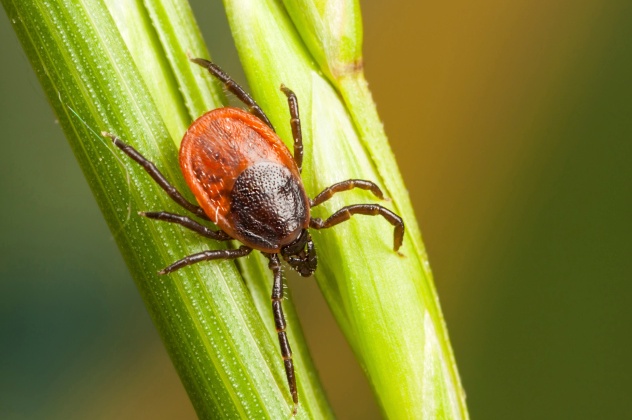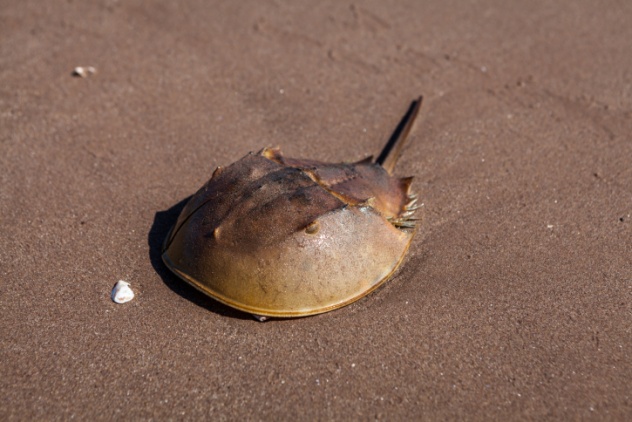(单词翻译:单击)
Every living organism on Earth is in some way related to something else. This genetic web gets larger and weirder the more scientists look at it. Finding new relations is a fascinating genetic puzzle where the most unexpected creatures can turn out to be cousins. It is also the ultimate tool for learning about evolution. The more creatures are linked to each other, the more they reveal about the history of themselves as individual species, their family group, and the progression of life on Earth.
地球上的一切生命体在某种程度上都和其他某种事物有联系。基因网越大越不可思议,就有越多的科学家前去研究。探索物种间的新关系是一项令人着迷的基因谜题,可能会发现最意想不到的几种生物居然是亲戚。这也是研究进化论的最根本途径。越多的生物之间存在相互联系,就越能够暴露它们的个体、族群和在地球上进化的历史。
10.Scorpions And Ticks
10.蝎子和蜱

Many people believe that ticks are insects, but they are not. They are true arachnids, closely related to scorpions and spiders. It’s an ancient lineage; one gene study tentatively suggested that these creatures were here before the dinosaurs, already crawling around the surface of the Earth 400–450 million years ago. For both ticks and scorpions, the next meal is primarily found by their excellent sense of smell, and they can only survive on liquid food. Ticks live on a diet of blood, while scorpions have a multipurpose venom that both paralyzes and liquifies their prey’s insides, which they then proceed to drink. Of the two, the scorpion is better adapted to survive the lack of nutrition and can go without eating for up to a year by adjusting its oxygen use and lowering its metabolism. Due to a lack of useful fossil evidence about the history of these arachnids, the same genetic study that placed them in primeval times also used their test results to support a theory that they hark back to a common, ocean-dwelling ancestor.
很多人认为蜱是一种昆虫,实则不然。他们是真正的蛛形纲动物,跟蝎子和蜘蛛有密切关系。它是一种古老物种的世系,一项基因研究初步表明这些生物存在于地球上的时间比恐龙还要早4-4.5亿年。蝎子和蜱主要是用敏锐的嗅觉来寻觅食物,而且它们只能依靠流质食物生存。蜱要生存下去必须保证每餐有血可饮,而蝎子有多种用途的毒液,可以麻痹溶解被捕者的内脏,然后它们就可以开始饮食。它们两个当中,蝎子更能够在食物匮乏的环境下生存,即使一年不进食也能存活,因为它们可以通过调节用氧量,降低新陈代谢的速度。由于缺少能证明其历史的化石,一个对原始时代的基因研究测试结果同样认为它们的祖先曾居住在海洋里。
9.Jellyfish And Coral
9.水母和珊瑚虫

One swims like a fish, and the other grows like a plant, but in truth, both are actually animals. Jellyfish and coral belong to the family group called cnidarians: bell- or tube-shaped animals that can deliver a burning sting with their tentacles. Despite this, they certainly don’t appear to be related. Jellyfish sting swimmers and pulse themselves through the water, while corals appear to be twig-like bonsais that do nothing. It comes down to body build, however. Cnidarians are sac-like creatures with a central opening around which the tentacles grow. This is more obvious with jellyfish. The coral frames often found in novelty stores are not the animal itself but a limestone coating built by them for protection and anchoring to a reef. The tiny individual corals are simplistic in design. They are cup-shaped sacs and have one opening that doubles as a means of both eating and excretion. They suck calcium carbonate from the ocean to build the branches that most people mistakenly see as coral. Thousands of minute coral animals stay around their limestone tree, using their tentacles to search for food.
一个可以像鱼一样的游动,另一个像植物一样的生长,但是事实上,他们都是动物。水母和珊瑚虫都是刺细胞动物家族里的一员,刺细胞动物就是钟形或管型动物,它们可以通过触须给你一种强烈的刺痛感。尽管这样,你仍然会觉得它们之间看起来没什么联系。水母会刺痛游泳的人并且能够在水里自由跳动,而珊瑚虫像是一盆满是树枝的盆栽,静止不动。然而实质上是主体结构让它们之间存在相互联系。刺细胞生物都是囊状生物,它们中心张开,周围生长着触须。水母在这方面的特征更加明显。常现身于新奇小店里的珊瑚虫框架并不是它本身的样子,事实上,那是由石灰岩涂层制作出来保护身体和定礁。那些小的个体珊瑚虫外形简单。它们杯状的囊只有一个开口,用来吸食和排泄。它们从海洋里吸收碳酸钙来筑建分枝,这也让大部分人看到珊瑚虫后会产生误解。其实,成千的珊瑚虫待在石灰岩“树”周围用它们的触角寻找食物。
8.Horseshoe Crabs And Spiders
8.马蹄蟹和蜘蛛

Horseshoe crabs were misidentified as crabs hundreds of years ago. Granted, they spend most of their time crawling over the sea floor and have a crab-like shell roughly resembling a horseshoe. However, they are grouped with arachnids. Horseshoe crabs date back 500 million years as a species. These prehistoric survivors, who perhaps never evolved to flourish on land like the rest of their cousins, can grow up to 0.6 meters (2 ft) wide and use their long tails as a tool to dig for food or to right themselves when upside down. Even more remarkably, the horseshoe crab has 10 eyes on its back and sides, can replace lost body parts, and has blue blood. The blood is medically valuable and is used to detect bacteria, for cancer research, and diagnosing leukemia as well as vitamin B12 deficiency. Sadly, a great number of horseshoe crabs are caught for their blood and also by the bait industry.
马蹄蟹在几百年前被错认为是蟹。大部分时间,它们都背着马蹄形的蟹壳在海底四处爬行。然而,它们却被归类为蛛形纲动物。马蹄蟹的起源可以追溯到五亿年前。这些史前幸存者可能不能像它们的近亲一样在陆地上蓬勃繁衍。马蹄蟹可以长到60厘米宽(2英尺),尾巴较长,用作挖掘食物的工具,还可以在它们翻倒的时候扶正身体。更引人注目的是,马蹄蟹的背部和身侧长有10对眼睛,身体的大部分器官都可以重生,并且血是蓝色的。马蹄蟹的血有极高的医学价值,可用于观察细菌、癌症研究和诊断白血病与维生素B12缺乏症。令人难过的是,人们为了马蹄蟹的血捕杀了大量马蹄蟹,此外马蹄蟹还被用于饵料工业。
审校:哎呀 校对:落花生 编辑:Freya然


